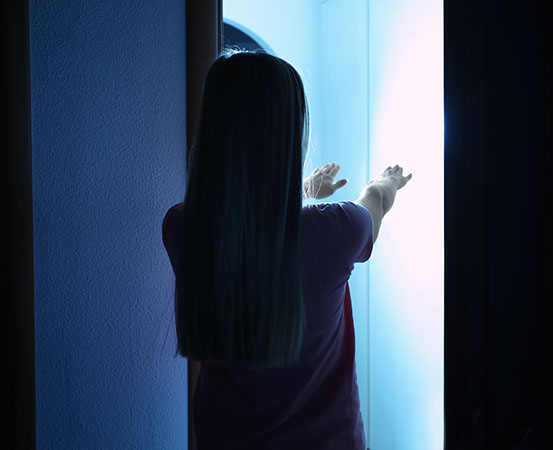
Recalling his childhood, 30-year-old Suhas C says, “I would open the door, step out of the house, open the compound gate and stand still.” So far, so good.
But the financial analyst from Bengaluru goes on to add, “Until my mother came searching for me and asked me to come back, I wouldn’t know what I was doing — and that too in the middle of the night.”
That a person can wake up at night, start walking inside the house and even open a door — all without their knowledge — can seem frightening. But sleepwalking or somnambulism is a common disorder in children and adults. It is classified under parasomnias (an abnormal disruption of sleep).
“A person suddenly starts moving in deep sleep, with their eyes sometimes wide open, and they are not [even] aware of that,” says Dr Puneet Khanna, head of department, respiratory medicine, HCMCT Manipal Hospitals, Dwarka, Delhi. “Because of the speed of walking, they do not remember the incidents at all. This happens with a person who has some sleep disturbances which lead to walking in deep stages of sleep — particularly in stage 3 of sleep.”
How common is sleepwalking?
According to the Sleep Health Foundation, an Australia-based charity, surveys suggest that two to three children in 100 sleepwalk often and about five in 100 sleepwalk sometimes. Among adults, three to four in 100 say that they have sleepwalked at least once in their lifetime, but only four in 1,000 continue to do so. Of those who sleepwalked as a child, fewer than a quarter have the disorder as adults too.
In Suhas’s case, the problem persisted in adulthood. “It was not just my childhood: I was living in a different city for work, and I used to get up, switch on the kitchen lights and stand still,” he says. “One such night, my friend got petrified and asked me what was happening. I then realised that I was sleepwalking even as an adult.”
What causes sleepwalking?
“During the REM sleep stage [dream state], the brain prevents the muscles in our limbs from moving — to protect us from acting our dreams out and hurting ourselves,” says sleep physician Dr Satyanarayana Mysore, who is also head of department, pulmonology, Manipal Hospitals, Bengaluru. “Sleepwalking can occur when there is a failure of paralysis of the muscles, allowing an individual to act on their dreams. Parasomnias can happen spontaneously, and they can happen due to short episodes of fever.”
Sleepwalking can also occur due to sleep deprivation, physical activity or even during emotional stress, he says.
“A specific genetic susceptibility is seen, but it is not mandatorily passed on from generation to generation,” Dr Mysore adds. “There are also triggering activities. Triggers may include medication-induced situations, especially sedatives, neuroleptic tranquillisers, antihistamine X. Sleepwalking can also occur during pregnancy, while some sleep disorders may get better during pregnancy.”
Dr Rahul Sharma, sleep specialist and additional director, pulmonology, Fortis Noida, Uttar Pradesh, says, “Some of the other common causes [of sleepwalking] are sleep deprivation, sleep-disordered breathing and sleep apnea. Kids can have the symptoms during the time of their anxious episodes such as fever or stress. Also, people who are hypnotically sedated for certain medications of psychiatric disorders can experience sleepwalking.
He says people who drink alcohol are also prone too sleepwalking. “People with restless leg syndrome also have a tendency to walk during sleep,” Dr Sharma adds.
How does sleepwalking affect people?
Experts say it is vital to have a detailed discussion with the individual who sleepwalks and their family members to understand the patterns of the disorder.
“Sleepwalking can invite medico-legal implications,” says Dr Mysore. “Therefore, most often our responsibility is to ensure that the doors are secured and the individual does not go out in the open. Cases of sleepwalking are seen in 1% to 17% of children, with the symptoms peaking between the ages of 11 and 12. The symptoms [reduce] later but may get precipitated during extreme conditions like [after having] fever medications.”
How is sleepwalking treated?
Dr Sharma says that among children it is most important to ensure they don’t fall or hurt themselves (by hitting a wall, for instance).
Adults usually require treatment — but while there are medications, identifying a core issue such as sleep apnea is the key.
Recalling a case, Dr Sharma says, “A young adult’s family came to me and said that he sleepwalks, whistles during sleep and goes back to sleep immediately. The family captured this in a video, which helped us to categorise it as sleepwalking.
“We [also] have an investigation called the video electroencephalogram (EEG) wherein a person who sleepwalks is monitored during sleep through a video camera and their brain movements are measured through the EEG. We [are thus] be able to understand if it is a [case of] parasomnia or something else.”
Takeaways
- Parasomnia in adults can be treated with medications.
- A ‘bed partner’ can help. If they observe the person next to them showing any ‘different’ movements during sleep, they can encourage the person to see a sleep specialist.
- Experts say if sleepwalking symptoms are not identified, the disease progression may become severe.

















